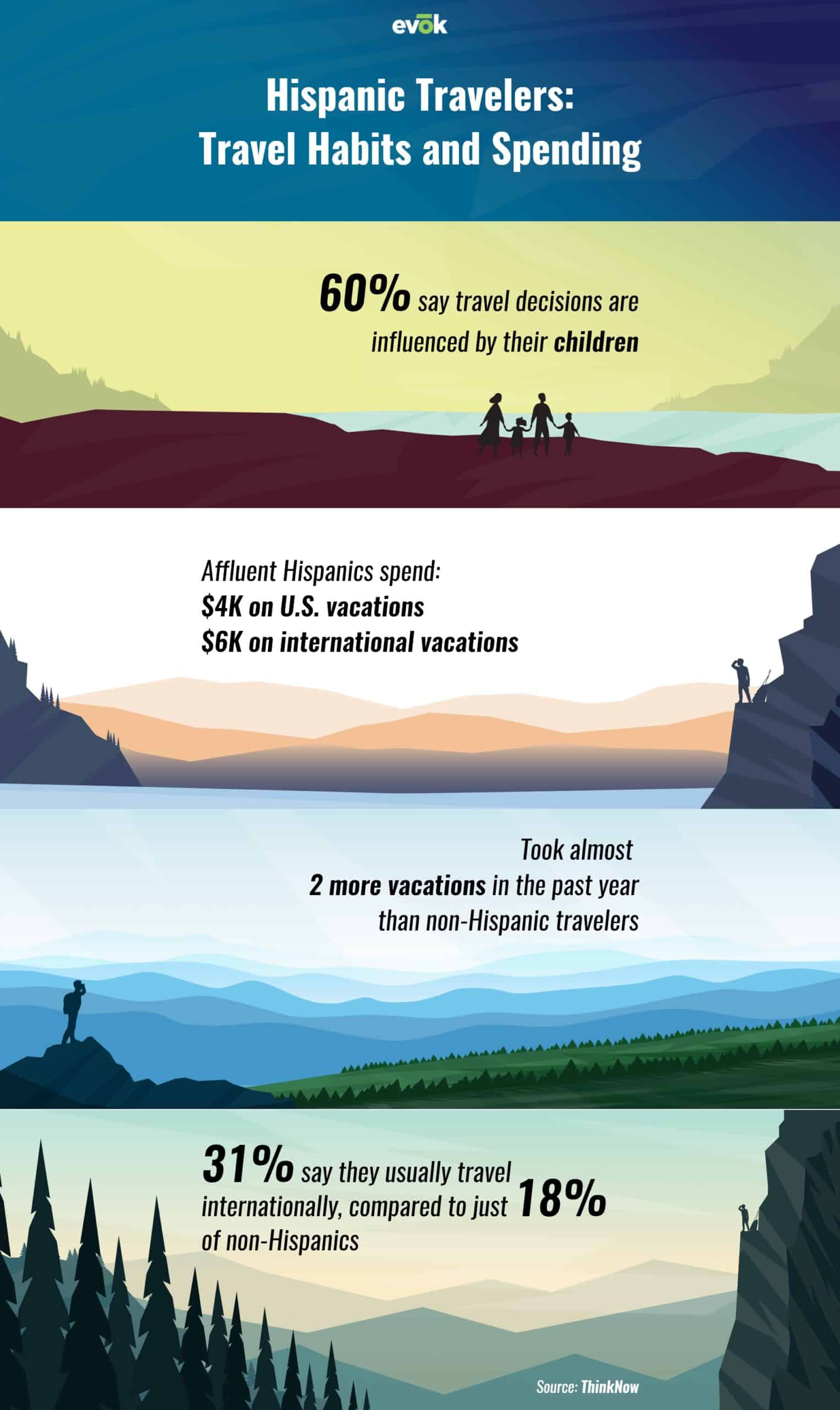
Hispanic Travel Trends: How to Influence Niche Travel Markets
This year, it’s forecasted that 71% of Americans will take a leisure vacation. How do you capture the attention of such a large audience? You narrow your scope. As the players of the travel and tourism industry fight to stay relevant in an evolving marketplace, it’s time to revamp your marketing strategy to include an audience you may be overlooking. As the largest minority in the U.S., Hispanic travelers are a largely untapped niche traveler market that could help reinvigorate your destination. Keep reading to learn more about the travel habits of U.S. Hispanics and how you can reach them through tailored marketing and more inclusive resources.

Overview of Trends
Do you want to capitalize on the Hispanic travel market but don’t know where to start? The best way to serve your audience is to understand their needs, motivations and habits. U.S. Hispanics have a uniquely strong attachment to cultural values and motivators that make them stand apart from other minorities. Below, we’ll dive into Hispanic and Latino traveler trends so you can cultivate a better understanding of your potential customers.
Who Is Your Future Visitor?
You may be surprised to learn that Hispanics across all income levels are more likely to travel than their non-Hispanic counterparts. However, the real opportunity for the travel industry lies with affluent Hispanics. According to ThinkNow research, wealthy Hispanics take an average of two more trips per year than affluent non-Hispanics. Not only are they going on more trips, but they’re also spending more by about $300 per trip, which can add up quickly.
In addition to going on more trips and spending more money, Hispanic travelers are also bringing more people. This culture has strong ties to family values and travelers are more likely to bring extended family and close friends along with them on their domestic and international trips.
How Do Hispanic Travelers Make Their Decisions?
Before you can capture the attention of a minority group with an increasing amount of purchasing power, you need to know how they make their decisions. Almost 60% of Hispanics said their children influence their travel decision-making, which tells us agencies and destinations should push family-friendly experiences that appeal to travelers of all ages.
Where Are Hispanic Travelers Going?
Research shows that affluent Hispanics are far more likely to travel internationally than their non-Hispanic counterparts. This niche group of travelers wants to explore what lies beyond U.S. borders and see the world. As a destination, you have the unique opportunity to reach these international travelers by appealing to their cultural values and advertising trips to their home countries. Not only will this pique their interest, but it will also make them feel valued as customers.
While Hispanic travelers enjoy international vacations, stateside destinations can still attract this growing niche travel market. Family and children are among the top deciding factors for this group and if you position your domestic vacation spot as the perfect retreat for families you may influence their travel habits.
How Do U.S. Hispanics Make Travel Plans?
While many people take travel plans into their own hands and rely on online resources, Hispanic vacationers are more likely to use a travel advisor or travel agency. These travelers are looking for an experience that is tailored to their interests and values, so traditional travel professionals are the best way to book a trip that suits their needs.
How to Engage with Hispanic Travelers

Now that you have a background on Hispanic and Latino travel habits, you can employ strategic marketing methods to influence their habits and draw them to your business.
Tailor Your Campaigns to Hispanic Values
How do you capture a potential traveler’s attention when the number of messages the audience is exposed to is at an all-time high? You need to build a campaign that speaks to what they personally care about.
As we’ve discussed, Hispanics are passionate about their culture and values, so destinations should create a message and choose placements that reflect this. In your marketing, this may look like promoting experiences with Spanish-speaking tour operators. Even customization as simple as that can make your destination stand out from the crowd as 82% of Hispanic travelers believe the tourism industry should value their business more. When your Hispanic customers feel seen and heard, not only will you create business opportunities in the present, but you can build a relationship that will bring return travelers.
Speak Their Language
A picture may be worth a thousand words, but images of beaches or mountains aren’t going to cut it when you’re trying to attract Hispanic and Latino travelers. Meet potential visitors where they are by making resources such as your website and social media campaigns available in Spanish.
Marketing research shows that Hispanic travelers are more likely to book a trip using a Spanish-speaking travel agent, so it would be beneficial for your organization to hire bilingual professionals to cater to this audience.
Choose The Right Channels
Even a perfectly crafted message can fall flat if you don’t choose the right channel placement. Make sure the content you share reaches your intended audience by putting it on the right platforms at times of peak engagement. Take some time to look into where Hispanic travelers are tuning in or find an agency that excels at creating opportunities for engagement. A good place to start? Learn more about the nuances of travel marketing on Google versus Facebook before you build your media plan and budget.
Another great way to connect with a group passionate about community and culture is to reach out to Hispanic travel influencers. If you offer a stay or experience in exchange for posts on their platforms, you can reach Hispanic travelers through a source they already trust.
Whether you’re trying to book leisure travel or grand international vacations, you can reinvigorate your destination by tapping into the niche travel market of Hispanic travelers.